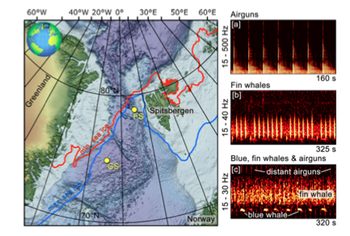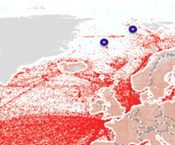Airguns infect summer soundscapes in remote polar Atlantic Ocean
Effects of Noise on Wildlife, Ocean, Ocean energy, Seismic Surveys Comments Off on Airguns infect summer soundscapes in remote polar Atlantic OceanAEI lay summary of:
Holger Klinck, Sharon L. Nieukirk, David K. Mellinger, Karolin Klinck, Haruyoshi Matsumoto, and Robert P. Dziak. Seasonal presence of cetaceans and ambient noise levels in polar waters of the North Atlantic. J. Acoust. Soc. Am. EL176, 132 (3), September 2012.
I somehow missed this study when it was published a couple years ago, but the findings are so striking that I can’t resist turning back the clock to cover it. Researchers from Oregon State University and NOAA’s Pacific Marine Environmental Laboratory analyzed data from two hydrophones deployed for a year in some of the most remote areas of the very northern Atlantic Ocean, and found seismic survey airgun sounds to be a dominant presence, audible for 95% of each day for five months a year (and over half the hours for two more months).
 Luckily for the fin whales who are the most populous marine mammal in these remote waters east of northern Greenland, they tend to show up toward the end of the summer airgun season, and concentrate their polar activity in the winter, when the airguns go silent. But blue whales and a relatively few sperm whales like to be there in late summer, and must co-exist with the steady rumble of airgun sounds, which increase the ambient sound levels by an average of 5-10dB, and up to 20dB. By contrast, the roar of storm-driven winter waves adds up to 12dB, and the calls of thousands of fin whales add up to 10dB.
Luckily for the fin whales who are the most populous marine mammal in these remote waters east of northern Greenland, they tend to show up toward the end of the summer airgun season, and concentrate their polar activity in the winter, when the airguns go silent. But blue whales and a relatively few sperm whales like to be there in late summer, and must co-exist with the steady rumble of airgun sounds, which increase the ambient sound levels by an average of 5-10dB, and up to 20dB. By contrast, the roar of storm-driven winter waves adds up to 12dB, and the calls of thousands of fin whales add up to 10dB.
The authors don’t speculate about the location of the seismic surveys being heard in the region, which lies well north of the Arctic Circle (the two sites are between 75 and 80 degrees north latitude; the Arctic Circle is at 66.5). But it’s a straight, if rather long, shot from the North Sea oil fields between the UK and Scandinavia, with Norway’s offshore arctic developments a bit closer. I suspect that the offshore concentrations of red between Norway and the study sites are likely active oil fields, with heightened airgun activity; the dark red North Sea hosts one of the world’s highest concentrations of ongoing seismic surveys.

What’s especially discouraging about these findings is that this is one of the increasingly rare parts of the world’s oceans that is largely spared the scourge of shipping noise. The more northern site lies close to a minor shipping lane between Norway and its remote arctic island outposts, but compared to the din of ships in most of the temperate latitudes (where shipping noise has roughly doubled in intensity each decade since the 1950s), this should be—or could—be an acoustic refuge. The map to the right shows the study areas, on the sparse fringes of the red cloud of global shipping routes. (Ed. note: Fish, which are not as wide-ranging as whales, and often use low-frequency sounds, are also likely affected by the increased background noise caused by airguns.)
The whales who visit seasonally seem to be putting up with the additional noise from seismic surveys; hundreds of blue whales are heard during 60-80% of hours in August and September, even as airguns continue to be heard nearly 100% of hours; the newly-arriving fin whales are heard close to half the time in those months, increasing to 70-80% of hours as their numbers climb to an estimated 6000 in mid-winter. Of course, at close range the whale calls are much louder than the distant airguns; but the steady hum of airguns at 5-10dB above what would otherwise be the background sound level can make it difficult for whales to hear their brethren across the dozens or hundreds of miles that they might otherwise communicate. As the authors note: “(D)uring the summer months. . . reverberation effects associated with the propagation of airgun signals often caused a continuous series of transient sounds.”
The authors note that recordings made in the early 1970s show winter-time sound levels similar to those recorded in this study; that study, however, did not find the summertime increase that is now associated with the distant seismic surveys.
